
|
Astronomy Picture Of the Day (APOD)
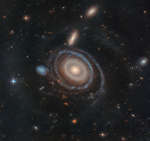 LEDA 1313424: The Bullseye Galaxy
LEDA 1313424: The Bullseye Galaxy
6.02.2025
The giant galaxy cataloged as LEDA 1313424 is about two and a half times the size of our own Milky Way. Its remarkable appearance in this recently released Hubble Space Telescope image strongly suggests its nickname "The Bullseye Galaxy".
 IC 2574: Coddington's Nebula
IC 2574: Coddington's Nebula
5.02.2025
Grand spiral galaxies often seem to get all the glory, flaunting their young, bright, blue star clusters in beautiful, symmetric spiral arms. But small, irregular galaxies form stars too. In fact dwarf galaxy IC 2574 shows clear evidence of intense star forming activity in its telltale reddish regions of glowing hydrogen gas.
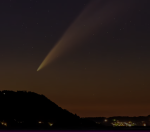 APOD: 2025 February 5 Б Comet G3 ATLAS Setting over a Chilean Hill
APOD: 2025 February 5 Б Comet G3 ATLAS Setting over a Chilean Hill
4.02.2025
Where is Comet ATLAS going? In the featured time-lapse video, the comet is not itself moving very much, but the Earth's rotation makes it appear to be setting over a hill. The Comet C/2024 G3 (ATLAS) sequence was captured with an ordinary camera on January 22 from the Araucanцa Region in central Chile.
 APOD: 2025 February 4 Б Anticrepuscular Rays: A Rainbow Fan over Spain
APOD: 2025 February 4 Б Anticrepuscular Rays: A Rainbow Fan over Spain
3.02.2025
Yes, but can your rainbow do this? Late in the day, the Sun set as usual toward the west. However, on this day, the more interesting display was 180 degrees around -- toward the east. There, not only was a rainbow visible, but an impressive display of anticrepuscular rays from the rainbow's center.
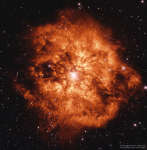 APOD: 2025 February 3 Б Wolf Rayet Star 124: Stellar Wind Machine
APOD: 2025 February 3 Б Wolf Rayet Star 124: Stellar Wind Machine
2.02.2025
Some stars explode in slow motion. Rare, massive Wolf-Rayet stars are so tumultuous and hot that they are slowly disintegrating right before our telescopes. Glowing gas globs each typically over 30 times more massive than the Earth are being expelled by violent stellar winds.
 APOD: 2025 February 2 Б Comet G3 ATLAS Disintegrates
APOD: 2025 February 2 Б Comet G3 ATLAS Disintegrates
1.02.2025
What's happening to Comet G3 ATLAS? After passing near the Sun in mid-January, the head of the comet has become dimmer and dimmer. By late January, Comet C/2024 G3 (ATLAS) had become a headless wonder -- even though it continued to show impressive tails after sunset in the skies of Earth's Southern Hemisphere.
 Nacreous Clouds over Sweden
Nacreous Clouds over Sweden
31.01.2025
Vivid and lustrous, wafting iridescent waves of color wash across this skyscape from northern Sweden. Known as nacreous clouds or mother-of-pearl clouds, they are rare. But their unforgettable appearance was captured in this snapshot on January 12 with the Sun just below the local horizon.
 The Variable Nebula NGC 2261
The Variable Nebula NGC 2261
30.01.2025
The interstellar cloud of dust and gas captured in this sharp telescopic snapshot is seen to change its appearance noticeably over periods as short as a few weeks. Discovered over 200 years ago and cataloged as NGC 2261, bright star R Monocerotis lies at the tip of the fan-shaped nebula.
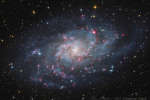 Hydrogen Clouds of M33
Hydrogen Clouds of M33
29.01.2025
Gorgeous spiral galaxy Messier 33 seems to have more than its fair share of glowing hydrogen gas. A prominent member of the local group of galaxies, M33 is also known as the Triangulum Galaxy and lies a mere 3 million light-years away.
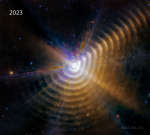 APOD: 2025 January 29 Б Dust Shells around WR 140 from Webb
APOD: 2025 January 29 Б Dust Shells around WR 140 from Webb
28.01.2025
What are those strange rings? Rich in dust, the rings are likely 3D shells -- but how they were created remains a topic of research. Where they were created is well known: in a binary...
|
January February March April May |
|||||||||||||||||||||||||||||||||||||||||||||||||